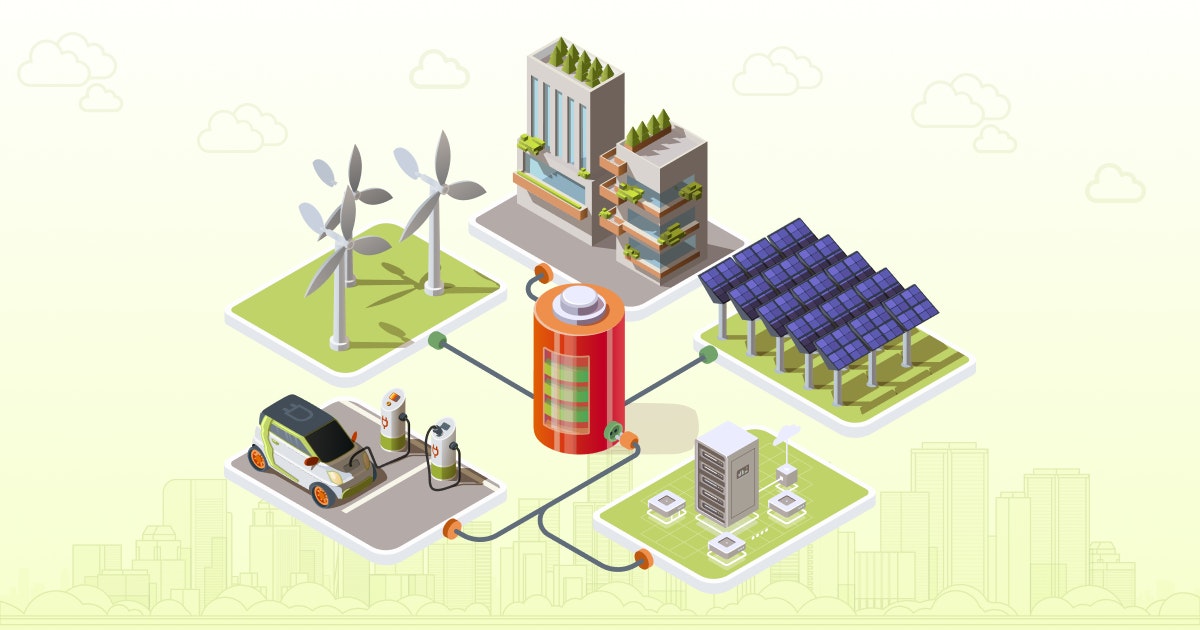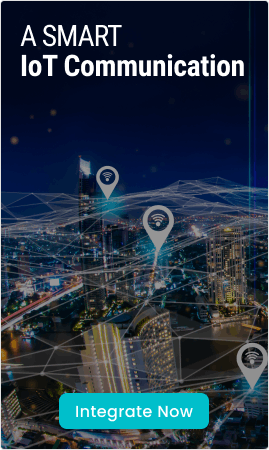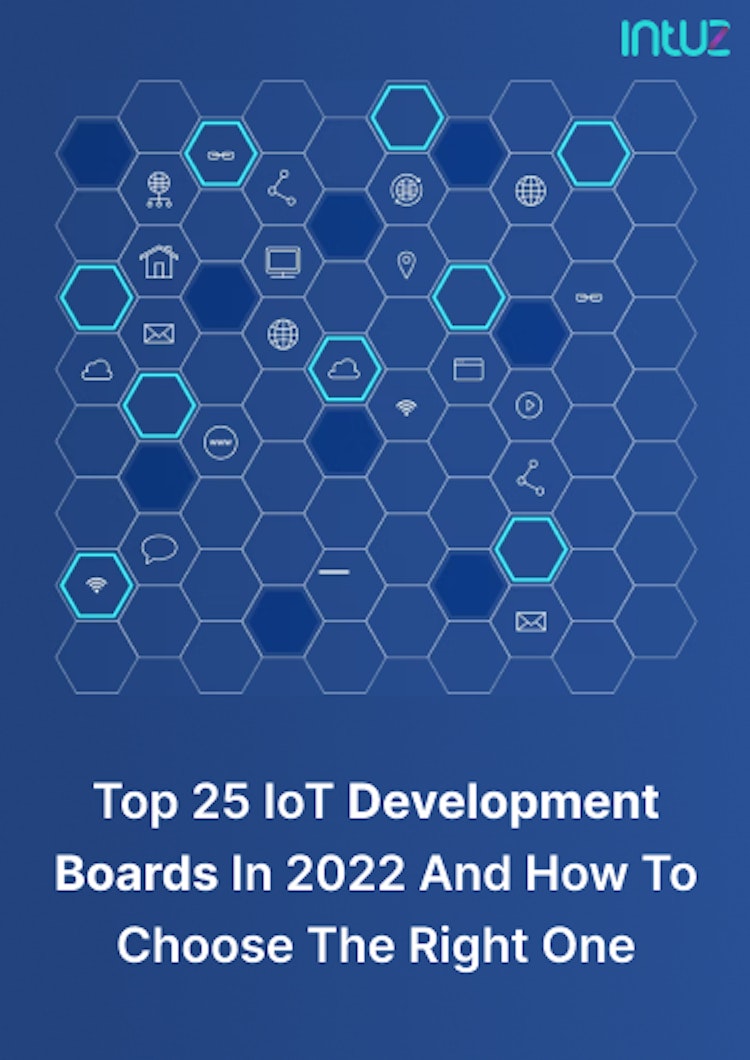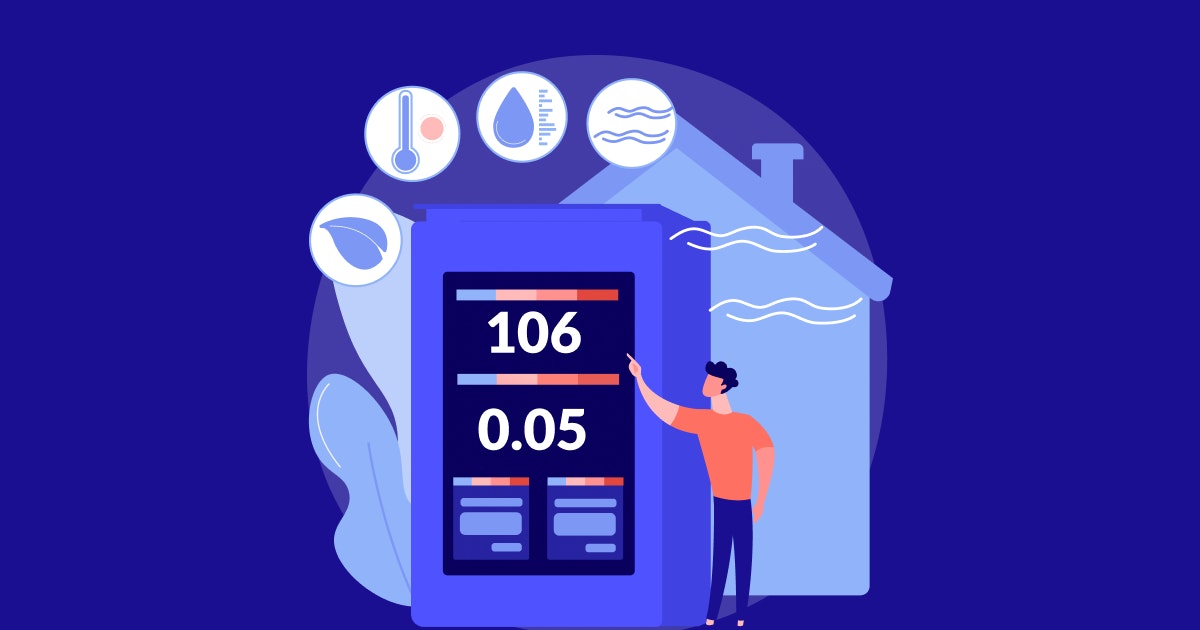Table of Content
Unless you live under a rock, you will agree that the traditional grid system is on its last leg. Today, it is hardly keeping up with the increasing electricity demand. No wonder governments worldwide are hell-bent on embracing and integrating smart grid technology.
They want to deliver economic, sustainable, and viable electricity supplies efficiently. In this article, we will study what makes smart grid technology so important nationally and globally and how IoT contributes to smart grid system development.
But first, let us get the basics out of the way and get an overview of the concept. So, what is smart grid technology? The constant rise in population and urbanization has largely impacted the climate. One can prevent the deterioration of the environment by developing carbon-neutral energy solutions.
Distributing electrical power to end-users requires a system of electrical wires, known as the grid. The main function of the grid technologies currently in use is to transfer the electricity produced at a central power plant.
Electricity transportation and distribution via conventional grids have some limitations and even lead to power loss. The arrangement has increased the need for energy-efficient solutions that securely transmit power.
A network with automated control and monitoring is called a smart grid. In terms of technology, a smart grid is a concept for conventional grids that includes cutting-edge and automated components to make them feasible in the long run.
A smart grid enhances current energy management systems to provide a reliable solution while minimizing the environmental impact. IoT-driven smart grid technologies help optimize and maintain traditional grids. They provide insights into the grid performance and can even make decisions based on the situation.
Numbers do not lie.
Research predicts that the smart grid market will grow at a CAGR of 17.76%, reaching $92.107 billion in 2026 from $29.336 billion in 2019. That means a surge in the use of smart grid tech across the globe would cause the advanced metering infrastructure to grow over the forecast duration.
The IoT-based smart grid has gained popularity manifold in the last couple of years and includes the following essential elements:
Smart grid sensors and meters record energy use data, while the sensors in smart appliances continuously create and report status, enabling monitoring and control.
Automated distribution systems use real-time data to detect overload, alter power distribution, and dynamically respond to demand fluctuations, resulting in increased safety and cost savings.
Smart storage and charging stations come in handy during outages or accidents. These technologies safely disconnect consumer networks from the grid. They also demonstrate the growing need for self-sufficient renewable energy solutions for domestic usage.
Smart grid tech - the backbone of smart cities
The smart grid is an essential component of sustained energy production. With new advancements like smart cities and electric vehicles that run on batteries, more cities worldwide are switching to renewable resources.
These can provide us with clean power 24/7, supporting the goals of sustainable living. Contributing to that objective, the USA has installed enough solar panels already. These have a solar capacity of 121 gigawatts (GW) that can power up to 23.3 million households.
According to the research data published by the Solar Energy Industries Association, the country's total generation capacity is primarily based on solar energy. The average annual solar energy adoption growth rate has been up by 33% in the last decade.
How IoT plays a vital role in smart grid tech
IoT is not just disrupting the energy industry; it is transforming energy generation and consumption processes to eliminate power wastage.
The smart grid's primary elements include power substations, distributed renewable energy sources, and smart home technology. Each of these is treated as a device on the IoT network.
The IoT-enabled device has an IP address that can be used to upload status updates and download command instructions. Working as edge computing devices, these help in optimizing the working of smart grids.
Modernize Your Grid with IoT Solutions!
Explore SolutionsSmart grid applications you should know about
Smart grids can resolve several problems associated with traditional electricity grids, including erratic outages and security-related mishaps. Common smart grid applications include:
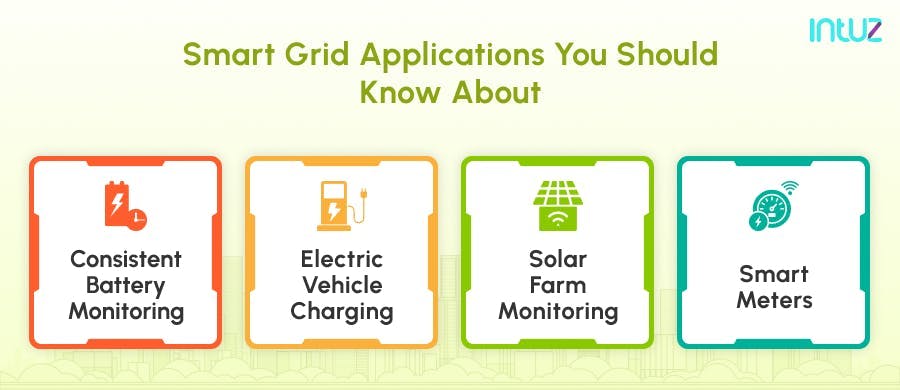
1. Smart meters
Smart metering works by establishing a channel of bi-directional communication between the devices themselves and the utility to gather, distribute, and evaluate energy consumption data.
The advanced metering options provided by smart meters are a significant advancement over automatic meter reading, which only allows for one-way communication and limits the scope for modifications to future IoT analysis. The utility collects, transmits, and processes data after an energy usage event with the automatic meter reading.
2. Solar farm monitoring
Smart meters and other IoT technologies can help companies and individuals improve the efficiency of their solar farms, which significantly reduces CO2 emissions in addition to providing a high return on investment. Smart grids and similar IoT-powered systems help solar farms streamline their operations.
3. Electric vehicle charging
One of the most important signs that carbon emissions will be reduced in the coming years is replacing fossil fuel-powered automobiles with electric vehicles (EVs).
However, providing drivers with reliable EV charging infrastructure is a major challenge. An IoT-based smart grid can ease the burden. It can connect with individual EVs and track charge levels continuously throughout a trip.
The monitors are linked to a GPS network that notifies nearby charging stations as the EVs charging goes down. IoT-based EV charging assistance technologies can accelerate the adoption of EVs for both personal and professional use. It will also support emission reduction objectives.
4. Consistent battery monitoring
Energy production from renewable sources is variable as it depends upon the availability of resources. Batteries help in storing the extra energy for future use. This extra energy can be distributed to other users on a smart grid.
However, when batteries are undercharged or overloaded with energy, it affects performance. It tends to shorten the battery life cycle, impacting customers or organizations that depend on it to store energy efficiently.
A battery's State Of Charge (SOC) can be monitored by smart systems to avoid premature failure brought on by undercharging or overcharging.
Securing The IoT Data Landscape: IoT Encryption Algorithms
Learn MoreUse cases of smart grid technologies
IoT supports various use cases of smart grids - from monitoring electricity generation to gauging smart power consumption and managing energy efficiency. Critical use cases of a smart grid are:
1. Remote management of utilities
Smart grids support remote management of utilities. They immediately limit access to energy and even shut down services upon detecting a delinquent account. Companies and customers can use remote control features to operate equipment, including smart home appliances, industrial air quality sensors, and industrial process management systems.
IoT software allows users to turn on and off assets or change their states as required - remotely. It can be a significant time and money-saving measure for users who depend on distantly-located smart grids.
Another vital feature of an IoT remote management function is the ability to remotely download and install fundamental software upgrades over the cloud and view and manage critical asset data from anywhere.
2. Superior demand management
Businesses can manage demand by using smart grids. They can maximize customer response by incentivizing them to use heavy equipment during non-peak hours.
For instance, customers can run their dishwashers or wash a load of laundry during periods of low energy demand. It helps them in saving money and reduce emissions.
Smart grid data apps can help end-users and businesses who are cost or environment conscious of keeping track of their energy consumption. In addition, providers can better customize their power supply to meet consumer needs rather than depending on projections.
3. Energy theft prevention
The energy sector suffers losses due to fraud and theft. It raises energy prices for customers and elevates the tax burdens on taxpayers, further impacting government energy subsidies.
Non-technical losses, such as energy theft, cost up to $100 billion annually. Customers may directly steal energy by connecting to the main supply, avoiding attempts at metering, or tampering with meters.
These thefts and frauds are harder to detect with traditional equipment. They can only be identified by physical unit inspections or auditing historical data.
IoT technology assists in theft detection and prevention by resolving non-technical losses in metering and billing. It keeps track of crucial indications, such as energy availability and usage, down to the meter in real time.
4. Efficient energy storage
Smart batteries allow energy distributors and even customers to store electrical energy. Besides ensuring healthy life cycles for the battery, a smart battery supports even distribution of energy to others on the grid.
5. Transparent billing
Traditional methods of energy billing involve visiting the meters to note readings and generate bills. However, in most cases, energy companies have been known to bill based on the projected usage. The problem arises when real consumption does not match the predicted usage.
Both providers and customers suffer because end-users receive inaccurate invoices, and suppliers have utilization constraints. Deploying IoT-powered smart grid technology requires the upgradation of the entire utility infrastructure to connected devices.
Though expensive, it offers improved data collection and communication capabilities, ensuring transparency in the billing process.
Advantages of smart grid technology
Imagine a scenario where electricity grids could communicate with each other. What if they could give us reliable information and allow managers to operate energy supply optimally across an entire country or area?
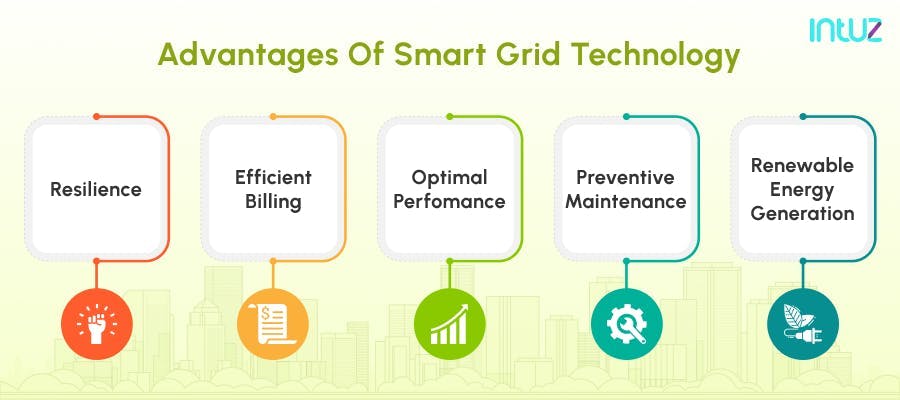
Trust us - this is no longer a fantasy, thanks to IoT. Even though smart grid technology is in its infancy, it has much to offer. Let us look at its benefits:
1. Renewable energy generation
Unlike traditional sources that transmit electricity to centralized power stations, smart grids accept power from homes and businesses, generating power from renewable resources. A smart grid is wirelessly connected with meters to monitor energy consumption and generation.
A net-positive facility is automatically compensated based on its supply. One can also monitor solar panels and other renewable power-generating devices through the smart grid.
Traditional methods are susceptible to widespread blackouts and energy shortages. On the other hand, the advantage of using a decentralized architecture is the connectivity with alternate energy sources.
2. Preventive maintenance
Key data points, including voltage, current, tilt, power, irradiance, and others, are recorded constantly by IoT devices. The data is utilized to determine the breaking point of components, and an alert is sent through the internet-connected microcontrollers.
Businesses receive real-time alerts related to system health. Any signs of deterioration are reported early on, enabling repair at a fraction of the cost. It prevents major faults in the crucial energy infrastructure and enhances the customer experience.
3. Optimal performance
Smart grid technology enabled by IoT drives digital transformation for utilities and customers. It aids in improving performance through the following:
- Grid optimization: Smart grids can assess pricing, availability, efficiency, and supply. Suppliers can use the data to improve the power supply and manage costs effectively.
- Energy storage: Smart batteries assist in saving energy by allowing utilities and even customers to store electrical energy.
- Monitoring: IoT tools can assist smart grids in monitoring important components. It notifies stakeholders about any upcoming issues to prevent supply disruptions.
4. Efficient billing
The smart grid will result in more effective billing for customers. According to regular billing methods, the cost of electricity consumed during peak demand is averaged across the city. But with smart meters, the charges are based on actual consumption. So you get an incentive to save electricity by turning off appliances during peak hours.
5. Resilience
Power may be instantly diverted from another source by using smart grid technology. It will minimize the impact of blackouts. IoT sensors report equipment health in real time, and utilities can use the information to plan maintenance activities. Alerts can be sent to the customers in case of an emergency.
A Guide To Actuators In IoT: Types, Anatomy & Examples
Learn MoreChallenges of smart grids
Although smart grids bring many advantages, they also have disadvantages. One of the biggest cons is the overhead costs of a smart grid can be massive, resulting in increased labor costs.
In addition, the presence of continuous data usage can violate privacy standards in many countries or continents. End-users are worried that law enforcers could use the data or be tracked by corporations for selfish reasons.
Where there is cloud technology, there is also the risk of security issues. Malware attacks can happen in any setting. Smart grids offer increased optimization of power networks. However, the connectivity leaves them vulnerable to cybercrimes.
Industries adopting the smart grid technology
IoT-powered smart grids are widely used across industries to automate processes and boost energy efficiency. From the household level to industries of all scales, the role of smart grids cannot be ignored. They deliver the following benefits:
Real-time monitoring of energy use and dynamic demand adjustment is made possible with automated metering.
The utilization of environmental data increases the use of renewable energy sources and improves energy production.
Grid load monitoring coupled with a data-driven automated action plan lessens the risk of outages or overloads.
Real-life examples of smart grid technology
Unsurprisingly, smart grids have found use in different applications and industry verticals. It has that much capability, and the technology will only make more strides with time. Without further ado, here are some prominent examples of smart grid technology from across the globe:
- A smart grid project implemented in Mannheim, Germany, used IoT infrastructure and technology solutions to coordinate energy use and production. The project supported the widespread use of renewable energy.
- The Lumin energy management platform is built for integrating smart grid IoT applications with home automation systems. It eases green energy adoption by lowering emissions and also enables cost savings. Customers can manage electricity use and storage through the company's smart panel and data analytics solutions.
- Schneider Electric offers networked solar power systems. Designed for residential use, these systems allow end-users to move off the grid entirely. They support solar power generation and conversion to meet the energy demand.
- Norway has almost achieved "clean energy." Ninety-six percent of electricity in that country is generated by hydropower. It also has a goal of selling no fossil fuel-powered vehicles by 2025. That is amazing! Norway is quickly on its way to becoming a fully renewable energy-powered nation.
- An energy retailer increased its profit margins by more than 20% after creating detailed end-user profiles using multiple data sets to guide a rise in pricing and avoid those at high risk of churn.
Smart Grid Challenges? Let's Solve Them with IoT!
Let's Get StartedOver to you
At Intuz, we know about the technologies used in an IoT power grid and energy-efficient ecosystems. We have the experience and expertise in developing IoT solutions for green energy projects, including designing and building software and middleware.
If you are working on a smart grid project or want to start afresh, look no further. We have what it takes to build an IoT solution that stands the test of time.
Book a Free 45-minute Consultation with Our IoT Experts Today! Get a customized roadmap and strategies to leverage IoT to boost grid efficiency.
